If only a few years ago I told you that AI is going to steal your jobs, you would have probably laughed at me. However, as time passes, that imagination is steadily turning into reality. Though AI chatbots like ChatGPT have mostly been used for fun conversations, several people, including students, have been using AI to write and copy text off other legitimate websites for their school assignments. However, there’s a way to combat this and detect AI-written content. Enter AI-powered plagiarism checkers, which can easily identify instances of plagiarism in seconds. If you are looking for reliable plagiarism checkers for ChatGPT and AI-generated content, you have come to the right place. In this article, let’s look at the 12 best AI plagiarism checker tools you can use in 2023.
Best AI Plagiarism Checker (2023)
1. OpenAI Text Classifier
We start with a recently released AI plagiarism checker by OpenAI, the company behind ChatGPT itself. Called the AI Text Classifier, the app is a finely tuned GPT model made by the company. The classifier is responsible for predicting how likely it is that an entered text has been written by a human or an AI.
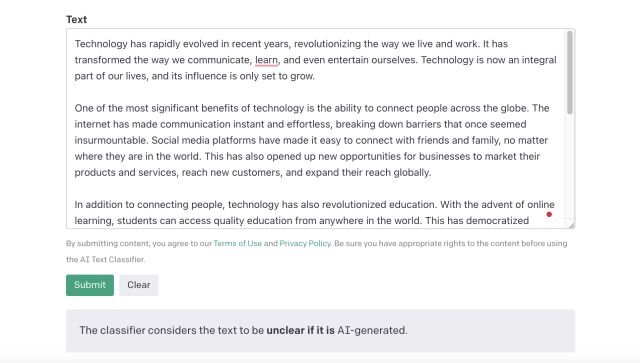
The AI plagiarism checker has been trained on pairs of data, including inputs from both humans and AI. This makes it easy for the tool to identify plagiarized AI text. The app works across all kinds of text and is based on the company’s website. OpenAI has also clearly stated that the tool isn’t fully reliable yet and should not be used as a primary way to identify copied text. However, I performed a few tests by copying my own article on Beebom and a few Wikipedia texts, and it was able to identify human text easily. This is one of the best AI plagiarism checkers that’s free to use but requires a minimum text input of 1,000 characters.
Try OpenAI Text Classifier
2. Copyleaks AI Content Detector
Copyleaks promises its AI plagiarism detector has 99.12% accuracy at finding out which content has been created by AI and humans each. The tool also has support for multiple languages, including French, Spanish, German, and more. Copyleaks uses what it calls a “fight fire with fire” approach, wherein the tool uses AI to detect AI-generated text. This gives the tool the ability to evolve alongside the newest AI chatbots and makes it capable. Copyleaks even promises support for ChatGPT 4 once it rolls out.
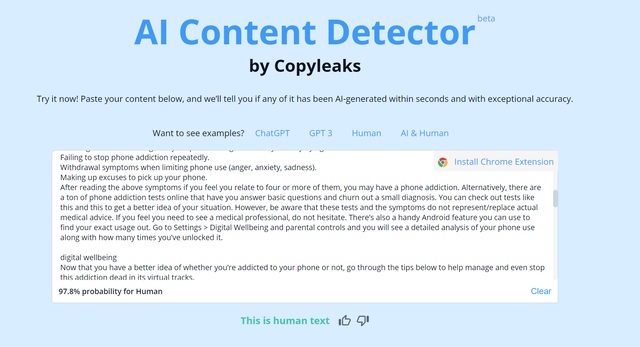
You can use this AI plagiarism checker for a variety of use cases, including articles, reviews, posts, and even academic papers. To give it a short jog, I copied text from an old smartphone addiction article on Beebom. The AI text detection tool took less than 10 seconds for over 600 words and gave me the green light (human-written text). I tried it out with several text excerpts, and it works accurately.
Moreover, if you can’t be bothered to open this website, there is also a handy Chrome extension (visit) for the tool. Copyleaks is also fully free to use, so go ahead and scan your text right away.
Try Copyleaks AI Content Detector
3. GPTRadar
An aptly named AI plagiarism checker, GPTRadar is another tool based on GPT-3 itself. Using the AI, the checker detects all manner of text online and classifies it as human or AI. The tool is available on a simple website that almost makes it seem too basic. Nonetheless, it works well and does the job. In addition to my articles, I copy-pasted Lorem Ipsum into the tool, and it gave some interesting results.
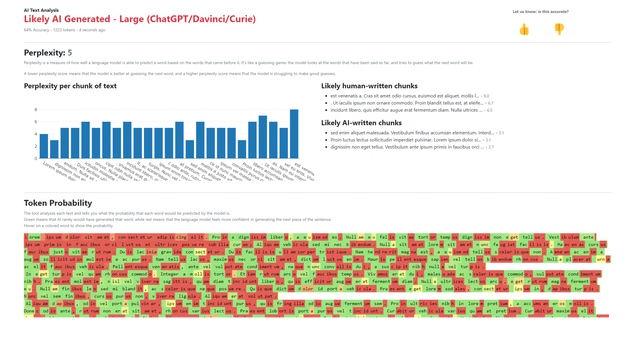
As you can see here, the tool says that the “Lorem Ipsum” text has likely been generated by a large AI model. Further, GPTRadar listed the text’s perplexity, which is the model’s ability to predict words. The tool also divided chunks of text based on whether they were human- or AI-generated. Besides that, this AI plagiarism checker gave loads of info, including token probability and distribution.
GPTRadar works on a token basis and gives free users 2,000 tokens for use. If you want more, you can buy additional credits for as low as $0.02, which translates to 100 tokens.
Try GPTRadar
4. CopyScape
This is another one of the best AI plagiarism checkers, but it works a bit differently. Instead of scanning text inputs from the user, this tool has the ability to scan entire web pages for you. To be more specific, CopyScape searches for copies of your web page on the internet and shows web pages that have plagiarised your content. CopyScape portrays itself as a tool for businesses to find if their content has been stolen. However, the service is perfectly capable of being used by individuals too.
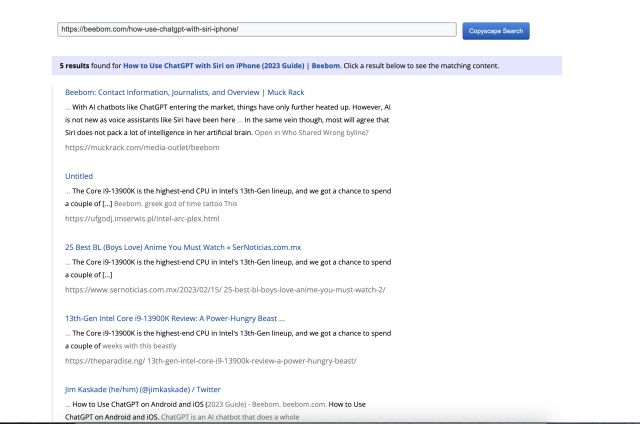
Using CopyScape is easy enough. Just copy and paste the URL of a web page into CopyScape, and the app takes a minute or two to render Google-like results, except for the copied content. You can then click on any of these results to see detailed information. The service even shows the exact word count and percentage of copied content. It works well and is generally accurate in detecting AI-generated text. CopyScape is free to use for now, but the company might paywall the website later on. Until then, try it out from the link below.
Try CopyScape
5. Content at Scale
Content at Scale has been trained on billions of pages of data and can accurately forecast the most probable word choices. This is one of the best AI plagiarism checkers and prides itself on using a proprietary content generator that taps into multiple layers of AI components. This makes it capable of combing through all kinds of AI, including ChatGPT, to detect plagiarised content.
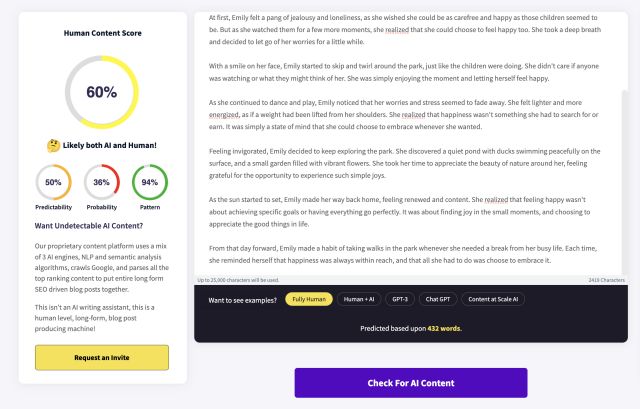
To test out this tool, I combined some pieces of self-written text with ChatGPT answers and pasted them here. The AI plagiarism checker finely scanned the entire content and gave a mixed result of AI and human output. As you can see, it highlighted the text in three different areas, which are predictability, probability, and pattern. To the tool’s credit, it’s extremely accurate, as I wrote a part of the text input. As before, Content at Scale is free to use, so go ahead and give this AI plagiarism checker a try.
Try Content at Scale
6. Plagibot
Plagibot is an AI plagiarism checker that allows users to upload various document types, including word files, PFDs, and more. The company has designed the AI checker to be friendly to users, as such it has a friendly UI. Plagibot maintains an up-to-date database to the point that it scrapes the web every hour.

This AI text detection tool catches plagiarism and generally identifies copied content from the original source. However, during my use, I found the website a bit prone to errors. Thankfully, it didn’t happen too often to affect my usage. However, remember that Plagibot is not free to use. Free tier users have a word limit of 2,000 per month, after which they must pay up. You can contact the company for prices if you wish to upgrade to a paid tier.
Try Plagibot
7. Writer AI Content Detector
Like some other services available online, Writer AI is a company that dabbles in AI writing besides detection. However, its AI plagiarism tool is adept at fishing out content that has been copied. The tool is simple to use and even has plans to come with a dedicated app for the company’s other services.
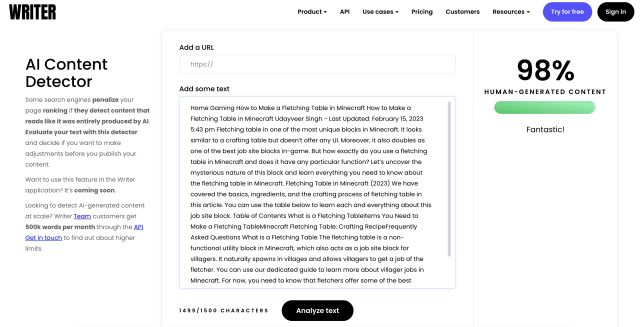
The Writer AI content detector works in the same way as others. Simply enter your copied or own created text and click Analyze. However, note that the tool is limited to 1,500 characters at once. If you need to check large pieces of text, you need to divide it into parts. If you are feeling lazy, you can input the web page URL, and it will pull the text for you. The tool uses a percentage meter to gauge whether the content has been plagiarised. I tried out the tool with a select few text inputs, and it could easily distinguish between human and AI-written text each time. For those looking to detect AI plagiarised content at scale, you will need to contact Writer AI.
Try Writer AI Content Detector
8. GPTZero
This AI Plagiarism checker has been recommended by many users online and mostly seems to hold its own. GPTZero is an easy-to-use AI content detector that works across different texts. The service uses statistical data to determine if the text is written by a human or not. Furthermore, it uses an algorithm that not only checks for originality but for other factors like perplexity and burstiness as well.
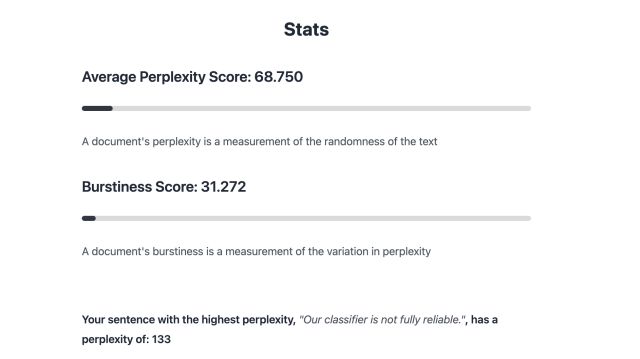
My experience with GPTZero was mostly positive, with just a few confusing moments. The tool easily differentiated between human and AI-generated articles. However, there was a time or two when it accidentally flagged the original text as AI-written. But it’s worth noting that happened rarely. I did appreciate the tool being specific about its metrics, which is something not a lot of AI plagiarism checkers do. Furthermore, the tool is completely free to use.
Try GPTZero
9. Corrector App AI Content Detector
While not every app on this list supports all the GPT models, the Corrector app’s AI content detector has extended support for all of them. It even supports the latest GPT 4 model, which has slowly started to roll out. Furthermore, this AI text detection tool also makes use of contextual cues in text inputs to identify similarities. Like other AI plagiarism detectors, anyone can use Corrector for a variety of their needs.
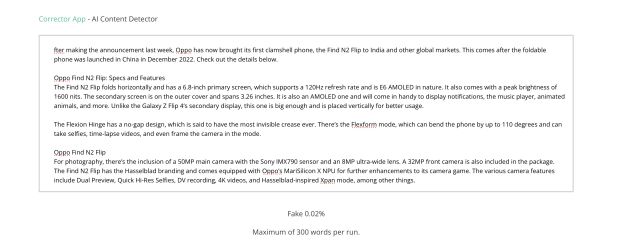
However, some might find the results a bit confusing. Instead of providing detailed metrics, the tool just has a Fake % meter that it uses to output the results. Pasting the content gives you percentage results. However, there is a maximum 300 words input limit that you must adhere to. On the bright side, the Corrector calls its app the “The Sherlock Holmes of AI detectors,” which is cool. Give Corrector a try and tell us how it performed for you.
Try Correct AI App Detector
10. Writefull GPT Detector
Writefull’s GPT detector is one of the new AI tools that online many have been using to detect fake Tweets online. The GPT detector is a simple-to-use tool trained on a variety of datasets to detect AI-generated texts. The tool works on instant detection, and you can use it in real-time.

To test out Writefull’s tool, I had ChatGPT compose a 500-word horror story and a news article published on Beebom. This GPT detector tool successfully identified the first as AI and the latter as human-written text. It uses a percentage scale to rank the likeliness of the text coming from an AI chatbot.
GPT Detector also has plans to add GPT 4 support and will update its existing model in the near future. While there is no paid subscription here, Writefull does mention that there’s a daily unmentioned quota in place. Nonetheless, the GPT detector is one of the best AI plagiarism checkers available right now.
Try Writefull GPT Detector
11. Crossplag AI Content Detector
Aimed particularly at finding AI written text in students’ assignments, Crossplag’s AI plagiarism checker can handle up to 1,000 words at a time. The content detector has been trained on a fine-tuned model of RoBERTa using the Open AI dataset, which makes it quite strong at detecting copied text. While the tool is still in the testing phase, it’s still fast at detecting plagiarised text.

To test the same, I combined human and AI written text rather than passing a single input through it. I made sure to keep the human side predominant to see if it detects the majority of it. While the tool did take a bit longer, it did return a satisfactory output. As you can see, the AI plagiarism checker gave me a 4% chance of this being written by an AI. Crossplag plans to make its tool available to institutions but not just yet. Furthermore, for that to happen, the detector will need to increase its language support from just English.
Try Crossplag AI Content Detector
12. Grammarly
While you might think Grammarly is only useful for, well, checking grammar, it allows you to quickly check for plagiarism. The tool uses a combination of AI technologies like machine learning, deep learning, and natural language processing. This not only helps Grammarly in improving writing but also copied text.
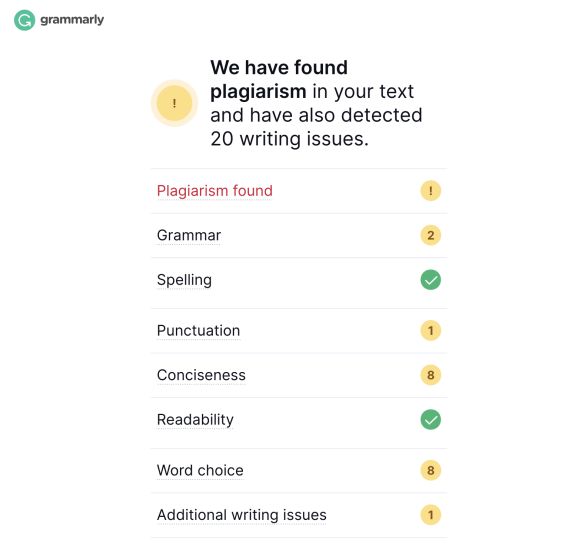
However, it’s worth noting that detailed plagiarism stats are limited because Grammarly has locked its best features behind a paywall. So while you can see if the tool has detected plagiarism or not, you can’t do much else. You can upgrade to the Premium version for $12 per month, though. Nonetheless, I tested a few pieces of text, and Grammarly detected them along with some other problems.
Try Grammarly (Premium $12 per month)
Use These Best AI Plagiarism Checkers to Stay Ahead of ChatGPT
I hope these plagiarism checkers help you find AI content that might have been sneakily slipped past you. These AI text detection tools will be a necessity in the coming months and will come in super handy for teachers and academics in detecting plagiarised or ChatGPT-written content. However, if you are on the other end of the spectrum and love AI’s potential, check out these cool things you can do with ChatGPT. Already covered all that? Learn how to use ChatGPT with Siri and give Apple’s voice assistant a much-needed boost. So which one is your favorite AI plagiarism checker? Let us know in the comments below.


